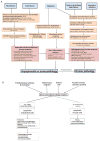Lymphatic filariasis: perspectives on lymphatic remodeling and contractile dysfunction in filarial disease pathogenesis
- PMID: 23237232
- PMCID: PMC3613430
- DOI: 10.1111/micc.12031
Lymphatic filariasis: perspectives on lymphatic remodeling and contractile dysfunction in filarial disease pathogenesis
Abstract
Lymphatic filariasis, one of the most debilitating diseases associated with the lymphatic system, affects over a hundred million people worldwide and manifests itself in a variety of severe clinical pathologies. The filarial parasites specifically target the lymphatics and impair lymph flow, which is critical for the normal functions of the lymphatic system in maintenance of body fluid balance and physiological interstitial fluid transport. The resultant contractile dysfunction of the lymphatics causes fluid accumulation and lymphedema, one of the major pathologies associated with filarial infection. In this review, we take a closer look at the contractile mechanisms of the lymphatics, its altered functions, and remodeling during an inflammatory state and how it relates to the severe pathogenesis underlying a filarial infection. We further elaborate on the complex host-parasite interactions, and molecular mechanisms contributing to the disease pathogenesis. The overall emphasis is on elucidating some of the emerging concepts and new directions that aim to harness the process of lymphangiogenesis or enhance contractility in a dysfunctional lymphatics, thereby restoring the fluid imbalance and mitigating the pathological conditions of lymphatic filariasis.
Keywords: filarial pathogenesis; host parasite interaction; inflammation; lymphatic contraction; molecular mechanisms.
© 2012 John Wiley & Sons Ltd.
Figures


References
-
- Amerini S, Ziche M, Greiner ST, Zawieja DC. Effects of substance P on mesenteric lymphatic contractility in the rat. Lymphat Res Biol. 2004;2:2–10. - PubMed
-
- Angeli V, Llodra J, Rong JX, Satoh K, Ishii S, Shimizu T, Fisher EA, Randolph GJ. Dyslipidemia associated with atherosclerotic disease systemically alters dendritic cell mobilization. Immunity. 2004;21:561–574. - PubMed
-
- Angeli V, Randolph GJ. Inflammation, lymphatic function, and dendritic cell migration. Lymphat Res Biol. 2006;4:217–228. - PubMed
Publication types
MeSH terms
Grants and funding
LinkOut - more resources
Full Text Sources
Other Literature Sources

